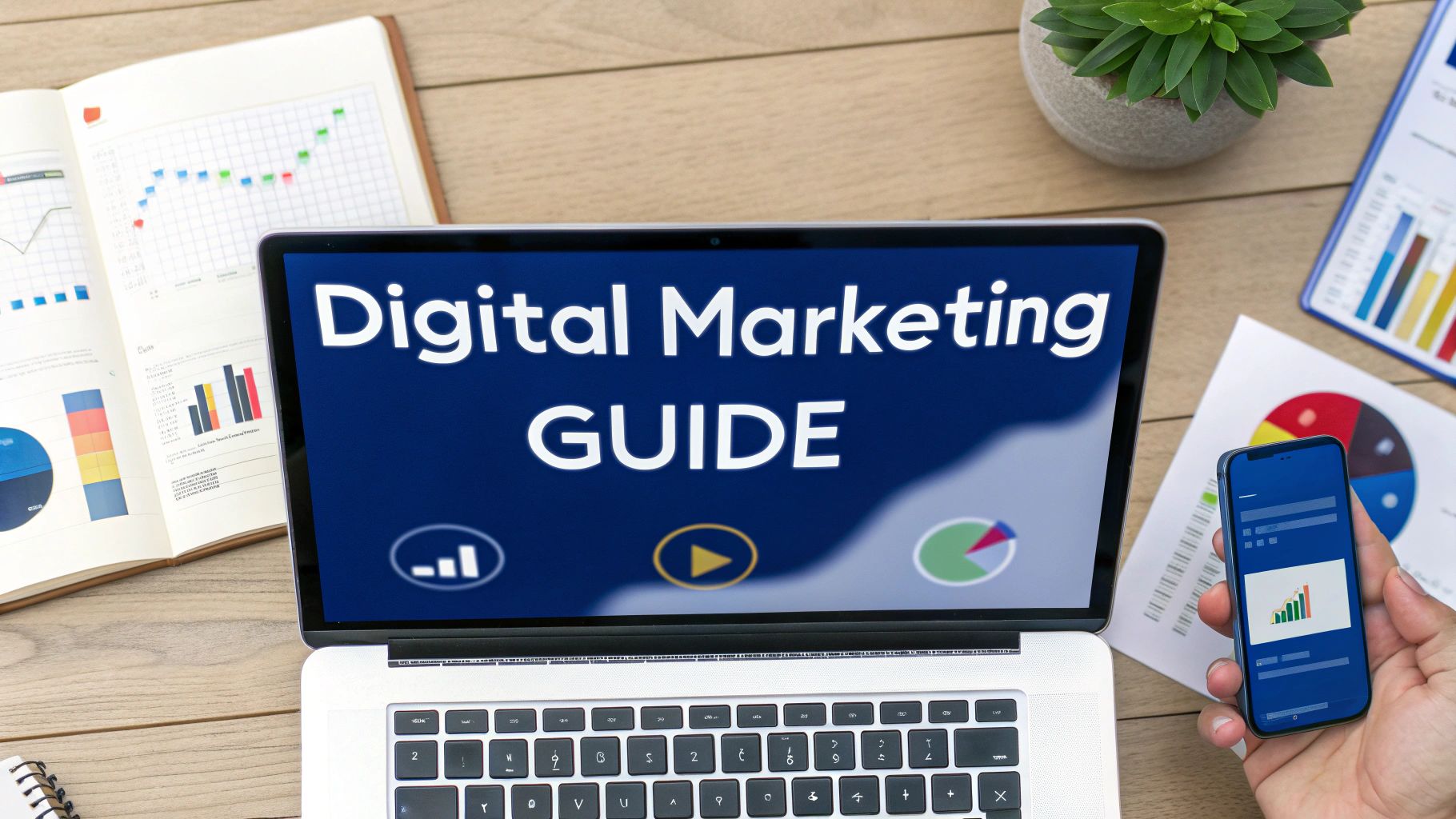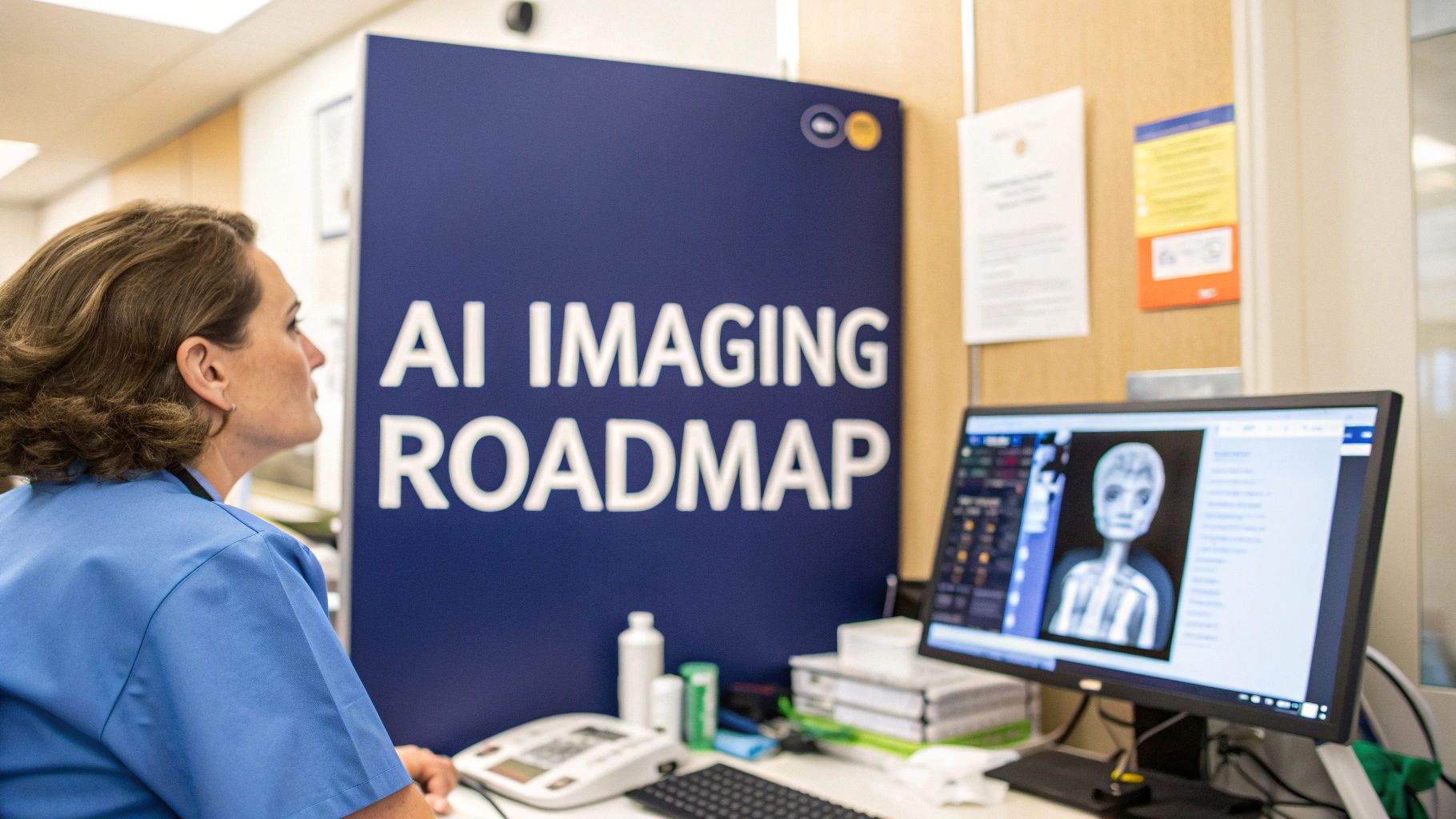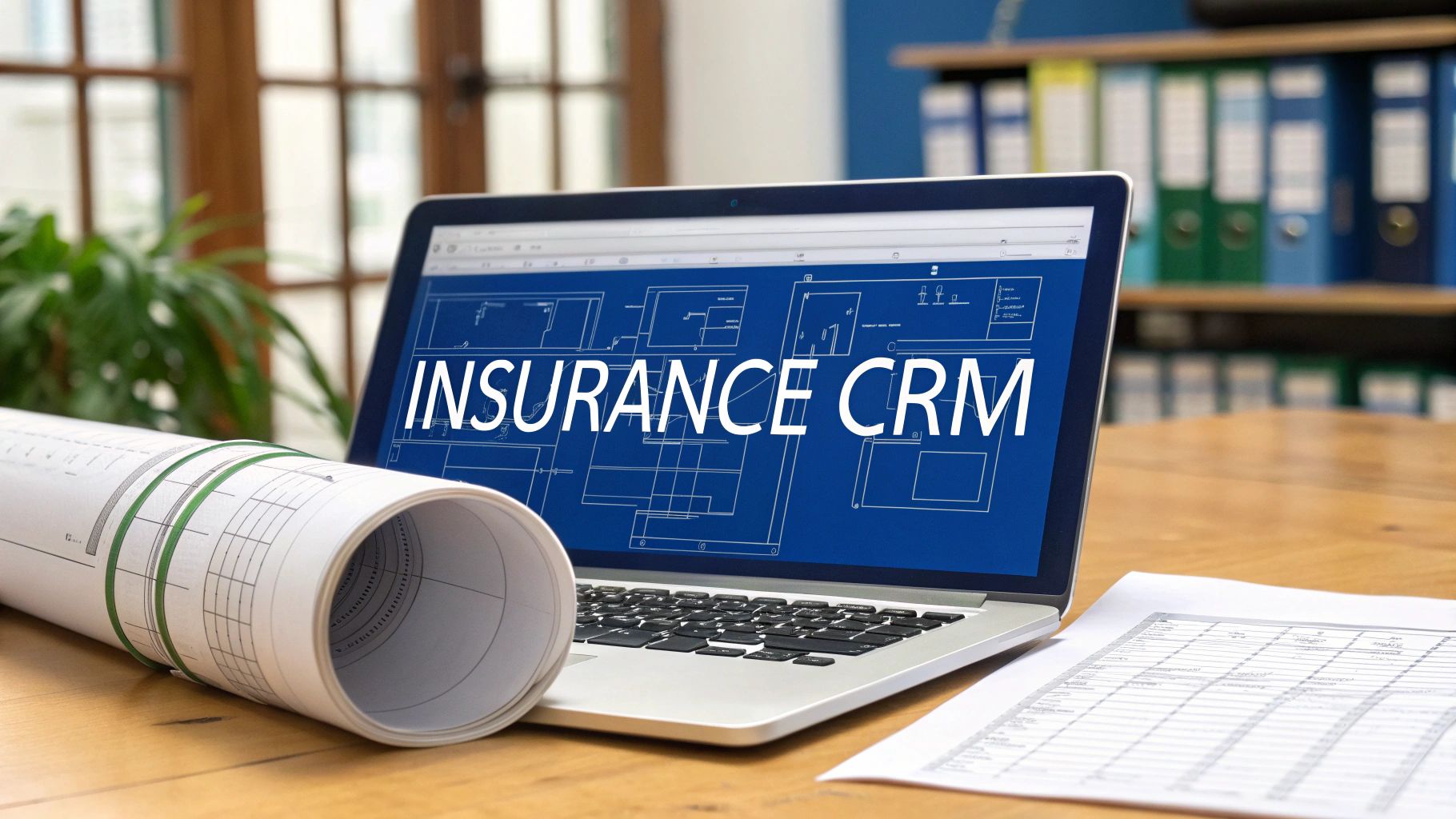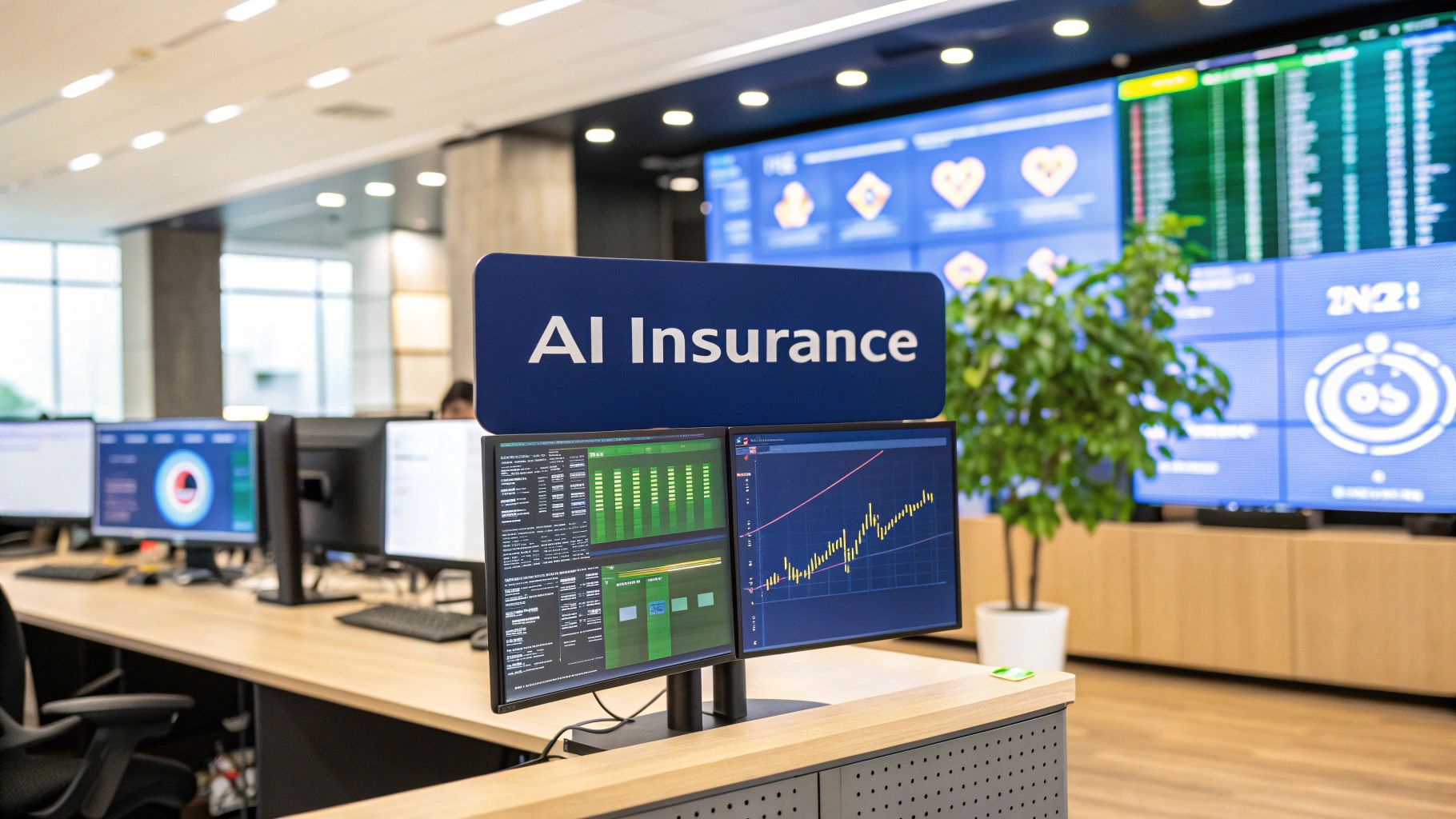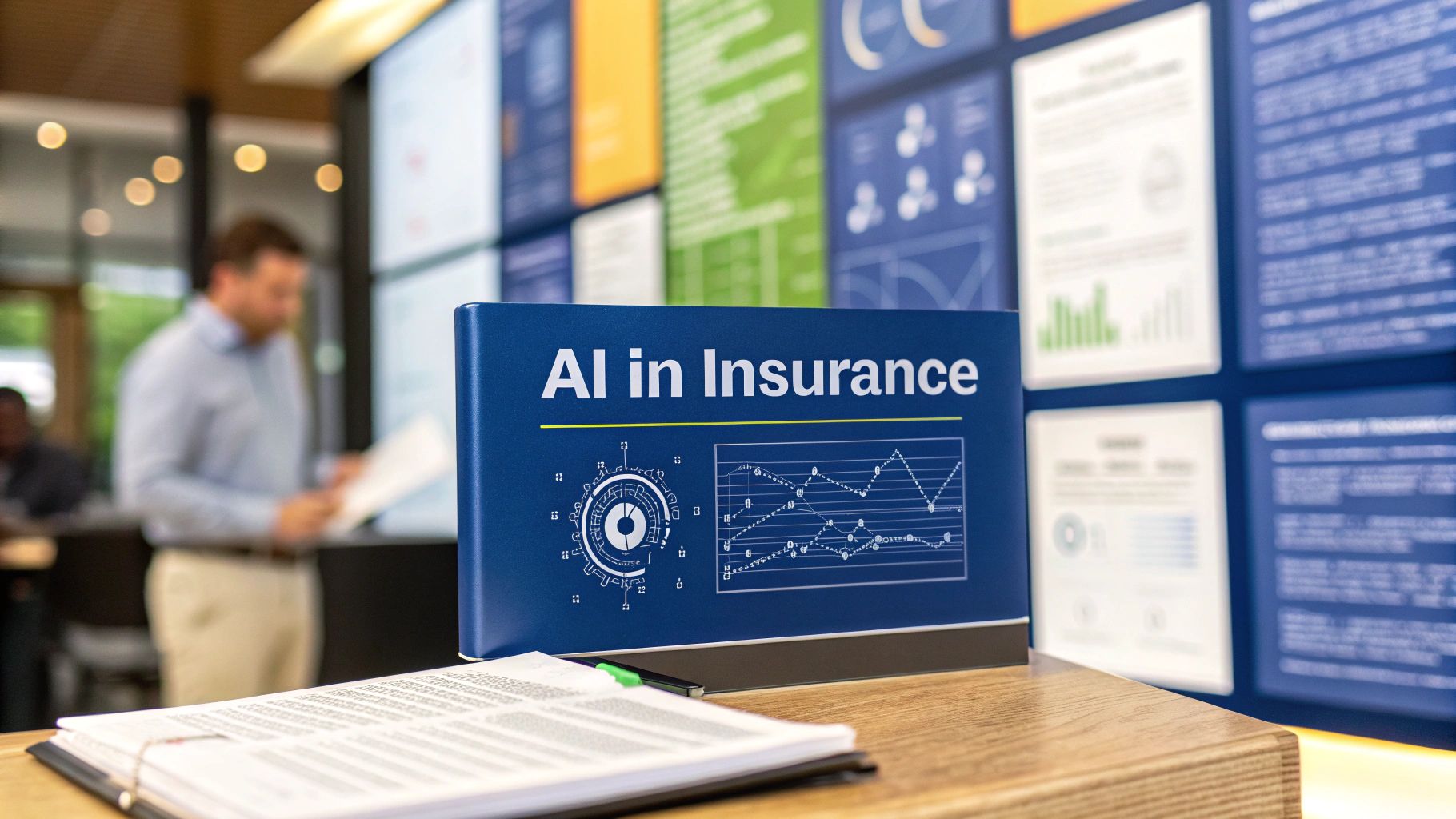For a small business owner, digital marketing isn't just another box to check—it's the new main street. It's about setting up your shop right where your customers are already spending their time: on Google, scrolling through social media, and checking their inboxes. A smart online strategy makes sure you're not just seen, but that you're trusted and chosen over the competition.
Why Digital Marketing Is Your New Main Street
Jumping into the online world can feel like opening a business in a huge, unfamiliar city. The sheer number of avenues—SEO, social media, paid ads, email—can feel overwhelming at first. But here’s a better way to think about it: these aren't just complicated technologies; they're the modern-day versions of tools you already understand.
Instead of relying on neighbourhood word-of-mouth, a solid digital plan lets you build a reputation across the entire city, or even the country. It’s about being the first result when someone searches "best coffee near me" or getting tagged in a local Facebook group when someone asks for recommendations.
Meeting Customers Where They Already Are
Let's face it, your customers live a good part of their lives online. They're searching for answers, browsing for products, and connecting with people. A great digital marketing for small business plan makes you a visible, helpful part of that daily routine. This isn't about shouting into the void with ads; it's about building genuine relationships and trust, just like a friendly, local shopkeeper would.
The shift to digital is undeniable. Post-pandemic studies found that 33% of small businesses now lean on social media as their main way to reach customers. This isn't just a fleeting trend; it’s a fundamental change in how businesses and customers connect.
Building Your Digital Toolkit
Every digital channel has a specific job to do, much like the different tools in a toolbox. Getting a handle on what each one does is the first step to building a strong online presence that actually works.
-
Your Website: This is your digital storefront. It’s the home base where people learn who you are, browse what you offer, and ultimately decide to buy.
-
Search Engine Optimisation (SEO): Think of SEO as the big, bright, welcoming sign above your shop's door. It's what helps people find you on search engines like Google when they need exactly what you sell.
-
Social Media Marketing: This is your spot in the town square. It's where you chat with customers, share what's new, and build a community of loyal fans who feel connected to your brand.
-
Email Marketing: This is your modern-day direct mail. It's perfect for sending personalized offers, updates, and news straight to the inbox of your most engaged customers.
The goal here is to replace that feeling of being overwhelmed with a sense of clear-headed confidence. Once you understand the 'why' behind each channel, you can start building a simple, effective roadmap for growth.
For a deeper dive into crafting a winning social media plan, you can learn more about mastering social media for small business success.
Build Your Digital Storefront with a Website and Local SEO

Think of your website as your digital storefront. It’s the one piece of online real estate that you completely own and control. This is where potential customers come to browse, learn your story, and decide if they want to do business with you.
Just like a physical shop, the experience matters. A great website acts as your best salesperson, working 24/7 to attract and inform. But it has to do more than just look pretty; it needs to work flawlessly. That means having a clear, intuitive layout that helps visitors find what they need without any frustration.
Your website is the central hub that all your other marketing efforts—from social media to email campaigns—will point back to. It’s the foundation of any effective digital marketing for small business strategy.
Designing a Website That Turns Visitors Into Customers
Your website's design can be the difference between a visitor sticking around or clicking away in seconds. For small businesses, three things are absolutely non-negotiable if you want to turn curious browsers into loyal customers.
-
Mobile-First Design: Let's face it, most people are searching on their phones. Your website must look and work perfectly on a small screen, with easy-to-tap buttons and text that doesn’t require pinching and zooming.
-
Effortless Navigation: People are impatient. They need to find key information—like your services, contact details, and hours—almost instantly. A confusing menu is the digital equivalent of a cluttered, unwelcoming storefront.
-
Clear Calls-to-Action (CTAs): Don't make people guess what to do next. Guide them with clear, direct buttons like "Book a Consultation," "Shop Now," or "Get a Free Quote." These are essential for generating leads.
Your website isn’t just a digital brochure; it's an active tool for growing your business. Its main job is to make it as easy as possible for a visitor to take that next step and become a customer.
For a deeper dive, check out these excellent small business website design tips to make sure your digital storefront is set up for success from day one.
Mastering Local Search with Your Google Business Profile
If your website is the storefront, then local Search Engine Optimisation (SEO) is the bright, glowing sign that guides people from all over town right to your door. For any business serving a local community, the most powerful and completely free tool for this is your Google Business Profile (GBP).
This is the information box that pops up in Google Maps and local search results when someone is looking for a business like yours. Claiming and fully optimising your profile is arguably the single highest-impact thing you can do for your local marketing.
This isn’t just a nice-to-have; it's essential. Over 90% of consumers now look up local businesses online before making a purchase. The data is clear: fully optimised Google Business Profiles see huge advantages. Profiles with photos get 42% more requests for directions and 35% more clicks through to their websites than those without.
Optimising Your Profile for Maximum Visibility
Making your Google Business Profile work for you involves more than just plugging in your address and calling it a day. It needs consistent attention to signal to Google that you’re an active, relevant, and trustworthy business.
To help you get started, here's a quick checklist of the most critical steps for optimising your Google Business Profile and website for local search.
Your Essential Local SEO Checklist
|
Action Item |
Why It Matters |
Quick Tip |
|---|---|---|
|
Complete Every Field in GBP |
A complete profile helps Google understand exactly what you do, making it easier to show your business to the right people. |
Don’t skip the “attributes” section! Add details like “wheelchair accessible” or “free Wi-Fi” to stand out. |
|
Upload High-Quality Photos |
Photos build trust and give customers a visual sense of your business before they even arrive. |
Add new photos regularly (at least monthly) showing your products, team, and happy customers. |
|
Encourage & Respond to Reviews |
Reviews are a massive ranking factor and provide powerful social proof that helps new customers choose you. |
Always reply to reviews, both good and bad. A thoughtful response shows you care and are engaged. |
|
Use Google Posts Weekly |
Posts keep your profile fresh and allow you to share timely updates, offers, and events directly in search results. |
Think of it like a mini-social media feed. Announce a sale, highlight a new product, or share a customer story. |
|
Ensure NAP Consistency |
Your Name, Address, and Phone number (NAP) must be identical across your website and other online directories. |
Inconsistencies confuse search engines and can hurt your local rankings. Do a quick audit to check for errors. |
By treating your website as your digital headquarters and your Google Business Profile as your number one local advertisement, you create a powerful combination that ensures you are found when and where it matters most.
Connect with Customers Through Content and Social Media

Having a great website and solid local SEO gets your business on the map. But content and social media are how you actually start a conversation. Think of these channels as your digital town square—a place to build a community, not just a customer list. The goal isn't to constantly shout "buy now!" It’s about creating genuine connections that make people want to stick around.
This philosophy is a huge part of modern digital marketing for small business. It shifts your focus from one-off transactions to building lasting relationships. When you share valuable, interesting content, you stop being a faceless company and become a trusted neighbour and go-to expert.
Choosing Your Digital Hangouts
One of the classic mistakes I see small businesses make is trying to be everywhere at once. Spreading yourself thin across every social platform is a fast track to burnout and lacklustre results. The real key is to be selective. Go where your ideal customers already spend their time.
Let's say you run a trendy local café. Your people are probably scrolling through Instagram and Facebook, looking at beautiful photos. That’s your spot to share mouth-watering pictures of your lattes and behind-the-scenes videos of your bakers at work. But if you’re a B2B consultant? Your time is much better spent on LinkedIn, sharing industry insights and connecting with other professionals.
Don't chase every shiny new platform. Instead, get really good at one or two channels where your community actually lives. Authenticity and consistency on the right platforms will always beat a scattered presence on the wrong ones.
Creating Content That Connects, Not Just Sells
Your content is your voice. It’s your opportunity to show off the personality behind your brand and offer real value that goes beyond just what you sell. When done right, content marketing builds your reputation as an expert and, more importantly, it builds trust. Trust is the bedrock of any lasting customer relationship.
For instance, a local hardware store could write a blog post on "5 Common Painting Mistakes and How to Avoid Them." This article doesn't push a specific brand of paint. It solves a real problem for the reader. By offering helpful advice, the store becomes a knowledgeable resource, making it the obvious place to go when that person is finally ready to buy their supplies. It's a simple strategy that builds authority and keeps you top-of-mind.
Practical Content Ideas for Your Small Business
Stuck on what to actually post? The best content usually does one of three things: it educates, entertains, or inspires. Here are a few ideas that work for just about any industry:
-
Behind-the-Scenes Glimpses: Show your team in action, the care that goes into making your product, or just a day in the life at your shop. It humanizes your brand and makes customers feel like they're part of the inner circle.
-
Customer Spotlights and Stories: Feature a happy customer (with their permission, of course!). Sharing their success story or a positive experience is powerful social proof that’s far more believable than any ad.
-
Tutorials and How-To Guides: Teach your audience something useful. A landscaping company could film a short video on how to properly prune roses, while a financial advisor could write a simple guide to creating a family budget.
-
Answer Frequently Asked Questions: Take those questions you get all the time and turn them into content. This not only provides immense value but also shows you're listening and saves you time in the long run.
By consistently creating content that genuinely helps people, you'll build a loyal following that trusts your expertise. For more inspiration, you can explore some practical tips for content marketing for small businesses to get the ball rolling. This approach isn't just about marketing; it's about building a real asset for your business, turning casual followers into devoted fans who will support you for years to come.
Reach Your Ideal Customers with Paid Ads and Email

While SEO and content are fantastic for building your long-term reputation, sometimes you just need to get in front of people who are ready to buy right now. That's where paid advertising and email marketing shine. Think of these channels as your direct line to specific, motivated customers.
Here's an analogy I like to use: organic marketing is like building a beautiful storefront on a busy street. Over time, the right people will naturally wander in. Paid ads, on the other hand, are like having a representative tap someone on the shoulder right as they’re about to walk into your competitor’s store and hand them a flyer for exactly what they were looking for. It's immediate, direct, and incredibly targeted.
Jumpstart Growth with Paid Advertising
Paid advertising platforms, like Google Ads or social media ads on Facebook and Instagram, let you pay to be seen. You're not waiting for customers to find you; you're placing your business right in their path. For any small business looking to make an impact, this is a must-have part of their digital marketing strategy.
The real magic here is the targeting. You can slice and dice your audience based on their location, age, interests, and even their recent online behaviour. A local plumber, for example, could run an ad that only shows up for homeowners within a 15-kilometre radius who have recently searched for "emergency pipe repair." That kind of precision means your budget goes toward people who actually need you, not just random browsers.
Paid advertising isn’t about volume; it’s about precision. Your goal is to spend your budget reaching the handful of people most likely to become customers, rather than shouting your message into a crowded, indifferent room.
You can get even more granular with advanced tactics. Learning how to use Google's custom intent audiences lets you target people who are actively researching the very products or services you sell.
Build Relationships with Email Marketing
If paid ads are about finding new customers, email marketing is all about keeping them. It's your most personal and direct line of communication. When someone trusts you with their email address, they’re inviting you into their inbox—that’s a welcome invitation, not junk mail.
The first job is to build that email list. The best way to do this is by offering something genuinely valuable in return for their contact info.
-
Offer a Discount: A simple "Get 10% off your first order" is a classic because it works.
-
Provide a Free Resource: A local restaurant could offer a PDF of their top recipes; a consultant could offer an exclusive industry checklist.
-
Host a Giveaway: Give people a chance to win a popular product or service in exchange for signing up.
Once you have a list, the real work begins. Send content your subscribers actually want to read. Don't just bombard them with sales pitches. Mix it up with helpful tips, behind-the-scenes stories, or company news. This builds a real relationship and turns one-time buyers into loyal fans who are actually happy to see your name pop up in their inbox.
Measure What Matters and Set a Realistic Budget
Let's be honest, success in digital marketing isn't about luck or just "being online." It’s about knowing your numbers. Diving into paid ads or pumping out content without a clear budget and a way to track what’s working is like driving blind. You'll burn through fuel and have no idea if you're even headed in the right direction.
So, let's talk about the two most important parts of your marketing engine: your budget and your analytics.
Think of website traffic as the digital equivalent of foot traffic—the number of people walking through your virtual front door. But just like in a physical shop, not everyone who walks in buys something. That’s where your conversion rate comes into play. It’s the percentage of those visitors who actually do what you want them to do, whether that’s buying a product, filling out a form, or signing up for your newsletter.
How to Set a Smart Marketing Budget
The big question for most small business owners isn't if they should spend on marketing, but how much. There's no one-size-fits-all answer, but a solid rule of thumb is to set aside 5-10% of your total revenue for your marketing activities. If you're a brand new business or really pushing for growth, you might even want to bump that up closer to 12% to build some early momentum.
The most critical piece of advice? Start with a budget you're comfortable with, even if it feels small at first. You can get surprisingly good results with a focused plan. The classic mistake is spreading your money too thin across a dozen different channels. Don't do that. Pick one or two channels where your ideal customers hang out and really invest there.
The goal of a marketing budget isn't just to spend money; it's to make a strategic investment. Every dollar should have a job to do, whether it's generating a new lead, making a sale, or building brand awareness.
Once you start to see a positive return, you can take those profits and reinvest them back into your marketing. This creates a powerful, self-sustaining cycle of growth.
The image below gives you a sense of how different channels perform when it comes to cost and conversions, which can help you decide where to put those first few dollars.

As you can see, paid channels can get you faster conversions, but organic efforts often deliver a lower cost-per-lead over the long haul. A healthy mix of both is usually the sweet spot.
Choosing the Right Marketing Channel for Your Business
To help you decide where to invest your resources for the best results, here’s a quick comparison of the top digital marketing channels.
|
Marketing Channel |
Best For |
Average Cost |
Key Metric to Track |
|---|---|---|---|
|
SEO |
Long-term, sustainable growth; building authority. |
Varies (content creation, tools); often lower than paid ads over time. |
Organic Traffic, Keyword Rankings |
|
PPC Advertising |
Quick results; highly targeted campaigns; driving immediate sales. |
Cost-Per-Click (CPC) can range from $1-$50+ depending on industry. |
Conversion Rate, Cost Per Acquisition (CPA) |
|
Social Media |
Building community; brand awareness; customer engagement. |
Can be low-cost (organic) or based on ad spend (paid). |
Engagement Rate, Follower Growth |
|
Email Marketing |
Nurturing leads; customer retention; direct communication. |
Low per subscriber; typically $10-$150/month for small lists. |
Open Rate, Click-Through Rate (CTR) |
Remember, you don't need to be on every channel. The goal is to choose the one or two that make the most sense for your specific business and customer base.
Tracking Your Success with Simple Analytics
You don't need a PhD in data science to figure out if your marketing is paying off. Free tools like Google Analytics are incredibly powerful and, honestly, pretty easy to set up. A tiny snippet of code on your website unlocks a goldmine of information about who your visitors are and what they do.
To keep things simple, here are the essential metrics every small business owner should be watching:
-
Users: This is the total number of unique people who visited your website. Is it going up each month?
-
Traffic Source: This shows you how people found you. Was it a Google search (organic), a Facebook ad, or a link from another site? This is how you spot your winning channels.
-
Bounce Rate: The percentage of people who land on a page and leave without clicking anywhere else. A high bounce rate could be a red flag that your page isn't giving visitors what they expected.
-
Conversion Rate: This is the big one. It tells you how many visitors are actually completing a goal, which is essential for calculating your return on investment (ROI).
By checking in on these numbers regularly, you can officially stop guessing. You’ll know exactly which parts of your digital marketing for small business strategy are bringing in the cash and which ones need to be tweaked or scrapped.
Putting Your First Digital Marketing Plan Into Action
Okay, enough with the theory. Let's get our hands dirty and see what this looks like in the real world.
We're going to map out a simple, effective digital marketing plan for a fictional small business: "The Daily Grind," a new coffee shop that just opened in a busy neighbourhood. You can use this as a blueprint for your own business.
First things first: what are we trying to achieve? For The Daily Grind, the goal for the first three months is simple and direct: Increase in-store foot traffic by 20%. Every single marketing effort needs to push us closer to that number.
Now, who are we trying to reach? We know The Daily Grind’s ideal customers are local office workers needing a morning caffeine fix and remote workers looking for a cozy place to work. Knowing this helps us pick the right spots to find them and craft a message that actually connects.
Choosing the Right Channels and Tactics
With a clear goal and audience in mind, we can be strategic about where we spend our time and money. You don't need to be on every platform. You just need to be on the right ones. For a local, visual business like a coffee shop, a smart starting mix is Local SEO, Instagram, and a basic email list.
Here’s the game plan:
-
Dominate Local SEO: The number one priority is making sure The Daily Grind’s Google Business Profile is polished and active. This means uploading high-quality photos of the coffee and space daily, adding the full menu, and actively asking customers for reviews to build trust. A simple sign offering 10% off for showing a new five-star review is a great way to get the ball rolling.
-
Create an Engaging Instagram Feed: For a coffee shop, it’s all about the visuals. The plan is to post three times a week, showcasing new drinks, behind-the-scenes snaps of the baristas, and customer features (with their permission, of course). Using local hashtags like #VancouverCoffee will help people in the area discover the shop.
-
Build a Loyalty-Focused Email List: A simple sign-up sheet at the till can offer a free pastry on a customer's next visit if they share their email. The strategy here is to send one newsletter a month with an exclusive coupon, news about shop events, and a "coffee of the month" feature. This is a powerful way to turn one-time visitors into regulars.
This plan isn't about doing everything; it's about doing a few things really well. Each tactic directly supports the main goal of getting more people through the door, creating a focused and efficient path to growth.
To really nail this, it helps to understand a solid digital marketing strategy framework, which can give your plan the structure it needs to succeed. It's what turns a handful of good ideas into a coordinated, powerful engine for your small business.
Common Questions About Small Business Digital Marketing
Diving into the world of digital marketing often raises a few practical questions. It's totally normal. Let's tackle some of the most common ones that pop up for small business owners, so you can move forward with a clear, confident plan.
How Much Should a Small Business Spend on Digital Marketing?
A solid rule of thumb is to set aside 5-10% of your total revenue for your marketing budget. If you're just starting out or really trying to make a splash in a competitive market, you might want to push that a bit higher, maybe closer to 12-20%, to build that crucial early momentum.
But here’s the most important part: start with a number you're actually comfortable with, even if it feels small. It's much smarter to pour that budget into one or two channels you can dominate—like nailing your local SEO or running some highly targeted Facebook ads—than to sprinkle a little bit of money everywhere and see no real impact.
Keep a close eye on what’s working. Once you see which activities are bringing in customers, you can reinvest your profits right back into those winning strategies.
Think of marketing less as an expense and more as a direct investment in your business's growth. As you start to see a tangible return, you’ll naturally feel more confident scaling up your spending.
What Is the Very First Step in Digital Marketing?
For nearly any local business, the absolute first thing you should do is claim and fully optimise your Google Business Profile. It’s a completely free tool from Google, and it's incredibly powerful. This one move gets you on Google Maps and puts you in the local search results precisely when people are looking for what you offer.
Honestly, it gives you the biggest bang for your buck (or your time, in this case). After that foundational piece is locked in, your next step really depends on what kind of business you run. If you’re a visual brand, like a flower shop or a café, heading over to Instagram makes perfect sense. On the other hand, if you provide services to other businesses, you'll likely find much better leads by building your presence on LinkedIn.
How Long Until I See Results from Digital Marketing?
This is the million-dollar question, and the answer really depends on the path you take. Some marketing channels are like a sprint, built for quick wins, while others are a marathon, designed to build a valuable asset for your business over the long haul.
-
Paid Advertising: Things like Google Ads or boosted posts on social media can start bringing in traffic and leads almost right away. It's not unusual to see clicks and calls within a few hours of launching a well-tuned campaign.
-
Organic Strategies: This is where things like Search Engine Optimisation (SEO) and content marketing come in. Think of these as long-term investments. You're building your brand's authority and visibility from the ground up. It generally takes a good 3-6 months of consistent work to start seeing a real climb in your search rankings and a noticeable increase in organic website traffic.
With organic marketing, patience and consistency are everything. Paid ads give you that immediate boost, but a strong organic foundation is what will keep attracting customers for years to come, without you having to pay for every single click.
At Cleffex Digital ltd, we live and breathe this stuff. We specialize in building digital marketing strategies that deliver real, measurable growth for small businesses just like yours. If you're ready to create a plan that truly works, we're here to help. Contact us today to get started.
